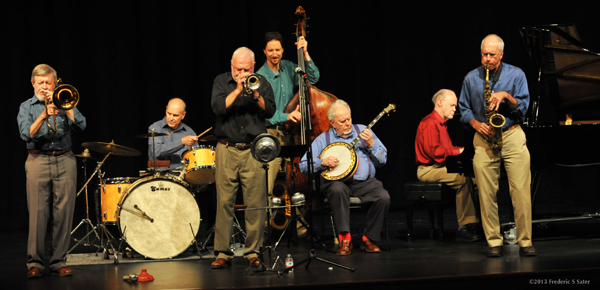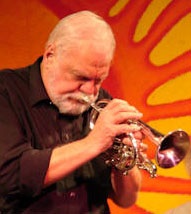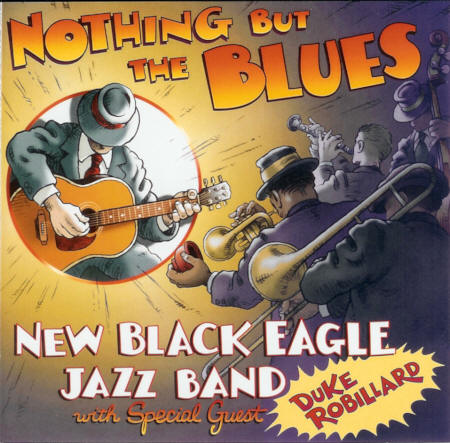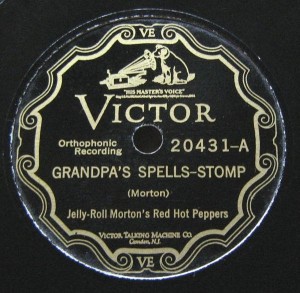
The New Black Eagle Jazz Band. Photo courtesy of the artists.
More than thirty years ago, the New Black Eagle Jazz Band played their first gig on a boat in Boston Harbor. Inspired by the pioneers of early jazz in New Orleans, the seven-piece band’s distinctive sound features a strong four-beat rhythm in the style of traditional players like the mythic New Orleans jazzman Bunk Johnson. In a concert recorded live in 2003 at the annual Jazz Jubilee in Sacramento, the Black Eagles make their Riverwalk Jazz debut with a program of hot jazz classics from the Big Easy to the Windy City.
The friendship between The Jim Cullum Jazz Band and the New Black Eagles goes back a long way. Jim was introduced to the band’s music in the mid-1970s by audiophile guru Ewing Nunn, who had recorded the Black Eagles in New Orleans and also did recording projects for Jim Cullum, the then owner of the Audiophile record label. This introduction led to a long friendship between members of the two bands and to a series of popular ‘Battle of the Bands’ concerts in Boston between The Jim Cullum Jazz Band and the Black Eagles. On this edition of Riverwalk Jazz, Jim and the Band step into the wings to enjoy the show and welcome the New Black Eagle Jazz Band to the stage of The Crest Theatre in Sacramento.

Cornetist Tony Pringle. Photo courtesy of the artist.
The Black Eagles are a favorite on the international jazz circuit and have been heard on several PBS television specials including Ken Burns’ Jazz and This Old House. From the NBEJB website: “We refuse to slavishly copy earlier jazz performances note for note, but are, at all times, aware of the legacy and influence from such legendary New Orleans musicians as Louis Armstrong, George Lewis, Kid Ory, Sidney Bechet, Jelly Roll Morton, Paul Barbarin and, of course, The Preservation Hall Jazz Band to name a few of those who represent the best in the history of New Orleans Jazz. We also have a good selection of Duke Ellington and Ragtime to spice the pot.”
The New Black Eagles have made the study of music played by early New Orleans jazz bands a lifelong pursuit, digging deep into the archives to come up with authentic repertoire of the period. Along the way, they have developed their own distinctive style, drawing inspiration from early New Orleans jazz players.
Cornetist Tony Pringle is our host for this concert. Other members of the band are: Peter Bullis, banjo; Stan Vincent, trombone; Bob Pilsbury, piano; Billy Novick, clarinet; Barry Bockus, bass; and Pam Pameijer, drums.
Playlist Notes:

CD cover image courtesy of New Black Eagle Jazz Band.
“Moose March“ is a typical early New Orleans street march.
“Sensation“ by Joseph Lamb, one of the major ragtime composers from the turn of the 20th century. Black Eagles bandleader Tony Pringle says early bands whose members were capable music readers made frequent use of “The Red Back Book” of classic piano rags and arranged its piano rags for band instrumentation.
Introducing the warhorse “C C Rider Blues,“ Pringle says, “If you can’t keep improvising on the blues without repeating yourself, you’re doing something wrong.”
“Over In the Gloryland,“ a traditional Spiritual. In 1928 The Sam Morgan Band of New Orleans featured trombonist Big Jim Robinson on the very first jazz band recordings of Spirituals. ‘Gloryland’ was one of the classics the Morgan band recorded. In later years, Robinson gained renown as a longstanding member of the Preservation Hall Jazz Band.
“Short Dress Gal,“ recorded by the Sam Morgan Band and other early New Orleans jazz bands, was also popular with early 20th century Cajun bands in the Mississippi Delta.
“Working Man Blues,“ from the output of the fabled King Oliver Creole Jazz Band, was recorded with Louis Armstrong on second cornet in Chicago in 1923.
“She's Cryin' for Me“ by New Orleans trombonist Santo Pecora.

Grandpa's Spells record label. Photo courtesy of mindspring.wordpress.
The Black Eagles interpretation of Jelly Roll Morton’s “Grandpa's Spells“ recalls Jelly’s 1926 Red Hot Peppers recording for the Chicago Victor label. Originally, Morton’s composition was a piano rag.
“Deep Henderson,“ from King Oliver and his Dixie Syncopators, has the early New Orleans feeling but demonstrates how the music was beginning to evolve from a simple folk music in New Orleans to the big city sophistication of the Swing Era.
“Tight Like This“ is the Black Eagles’ salute to the Louis Armstrong and Earl Hines collaboration of 1928 in Chicago known as the 'Hot Five.'
Photo credit for Home Page: The New Black Eagle Jazz Band. Image courtesy the artists.
Text based on Riverwalk Jazz script by Margaret Moos Pick ©2003

